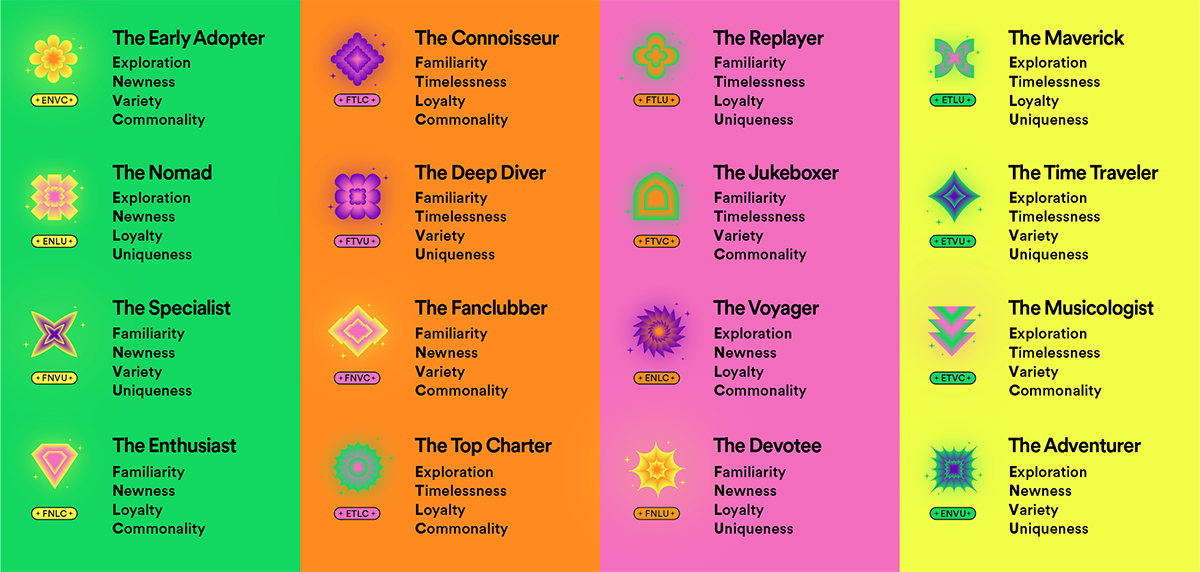HYPEBOT – Spotify introduced 16 new distinct “Listening Personalities” as a key factor in determining each user’s 2023 Spotify Wrapped.
Listening Personalities are a combination of four attributes that each try to measure and describe an aspect of how a fan listens to music on Spotify, independent of what kind of music they like.
While it’s unclear yet where else Spotify is using Listening Personalities, understanding how they work and where your fans and music fit can offer insights into how to release and market music in ways that fit their “personalities.”
Do an artist’s fans value “familiarity” and, therefore, might react well to them releasing alternative versions of tracks and perhaps doing more cover songs? Or do the fans value “newness,” and therefore, an ongoing stream of new releases bear more fruit?

Spotify Listening Personalities
Spotify’s Glenn McDonald describes “Listening Personalities” and offers examples of the four core attributes:
F/E: Familiarity vs. Exploration
“This one measures how much of your listening is spent playing your favorite artists vs. discovering artists you don’t know. Technically we have a score called “affinity” that measures your apparent dedication to each artist you play, and the F/E score is the sum of the inverses of these affinity scores. So if you only ever listened to one artist on permanent repeat, that would produce the maximum possible Familiarity score. If you spent every waking moment playing music but never played any single artist more than once, that would produce the maximum possible Exploration score.”
T/N: Timelessness vs. Newness
“This one measures how much of your listening is spent playing new or old music. The newer a new song is when you play it, the more it nudges you toward Newness. Every song you play that isn’t new nudges the other way toward Timelessness. If you spent every week listening to only that week’s new releases (like, for example, if you were me), that would produce the maximum possible Newness score. If you studiously manage to listen to a lot of music without ever playing anything new, that would produce the maximum possible Timelessness score. Both ways are fine. The past is effectively just as infinite as the future at this point.”
L/V: Loyalty vs. Variety
“This one measures how much of your listening is spent playing the same songs or different ones. If you played just one song on repeat all the time, that would produce the maximum possible Loyalty score. At least with streaming, you can’t wear out the bytes. If you had music going constantly but never played any song more than once, that would produce the maximum possible Variety score. (If you want to try this, I maintain a playlist that automatically updates every day with 1,000 songs chosen randomly from the Spotify catalog: here.).”
C/U: Commonality vs. Uniqueness
“Sometimes you listen to music in order to know the songs that everybody else knows or that your friends know. Sometimes music is how you differentiate your own identity. This one measures this by keeping track of how popular each song you played was on each day you played it. If you played each day’s #1 global song on Spotify on repeat all that day, every day, that would produce the maximum possible Commonality score, and you would definitely be prepared to talk to strangers about Harry Styles and Taylor Swift. If you played nothing but artists nobody else had listened to yet, that would produce the maximum possible Uniqueness score, and you would definitely be prepared to annoy Harry Styles and Taylor Swift fans by talking to them about music that neither they nor anybody else has heard of.”
Take a deeper dive here.
Bruce Houghton is the Founder and Editor of Hypebot and MusicThinkTank, a Senior Advisor at Bandsintown, President of the Skyline Artists Agency, and a professor for the Berklee College Of Music.





























